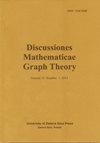Dominated Pair Degree Sum Conditions of Supereulerian Digraphs
IF 0.5
4区 数学
Q3 MATHEMATICS
引用次数: 0
Abstract
Abstract A digraph D is supereulerian if D contains a spanning eulerian subdigraph. In this paper, we propose the following problem: is there an integer t with 0 ≤ t ≤ n − 3 so that any strong digraph with n vertices satisfying either both d(u) ≥ n − 1 + t and d(v) ≥ n − 2 − t or both d(u) ≥ n − 2 − t and d(v) ≥ n − 1 + t, for any pair of dominated or dominating nonadjacent vertices {u, v}, is supereulerian? We prove the cases when t = 0, t = n − 4 and t = n − 3. Moreover, we show that if a strong digraph D with n vertices satisfies min{d+(u)+d−(v), d−(u)+d+(v)} ≥ n−1 for any pair of dominated or dominating nonadjacent vertices {u, v} of D, then D is supereulerian.超欧拉有向图的控制对度和条件
如果有向图D包含一个生成欧拉子图,则D是超欧拉图。在本文中,我们提出了以下问题:是否存在一个0≤t≤n−3的整数t,使得任何有n个顶点的强有向图既满足d(u)≥n−1 + t又满足d(v)≥n−2 - t或者d(u)≥n−2 - t又满足d(v)≥n−1 + t,对于任意支配或支配的非相邻顶点{u, v},都是超欧拉图?我们证明了t = 0, t = n - 4和t = n - 3的情况。此外,我们证明了如果一个有n个顶点的强有向图D满足min{D +(u)+ D−(v), D−(u)+ D +(v)}≥n−1,对于D的任意对支配或支配的非相邻顶点{u, v},则D是超欧拉的。
本文章由计算机程序翻译,如有差异,请以英文原文为准。
求助全文
约1分钟内获得全文
求助全文
来源期刊

Discussiones Mathematicae Graph Theory
MATHEMATICS-
CiteScore
2.20
自引率
0.00%
发文量
22
审稿时长
53 weeks
期刊介绍:
The Discussiones Mathematicae Graph Theory publishes high-quality refereed original papers. Occasionally, very authoritative expository survey articles and notes of exceptional value can be published. The journal is mainly devoted to the following topics in Graph Theory: colourings, partitions (general colourings), hereditary properties, independence and domination, structures in graphs (sets, paths, cycles, etc.), local properties, products of graphs as well as graph algorithms related to these topics.
 求助内容:
求助内容: 应助结果提醒方式:
应助结果提醒方式:


